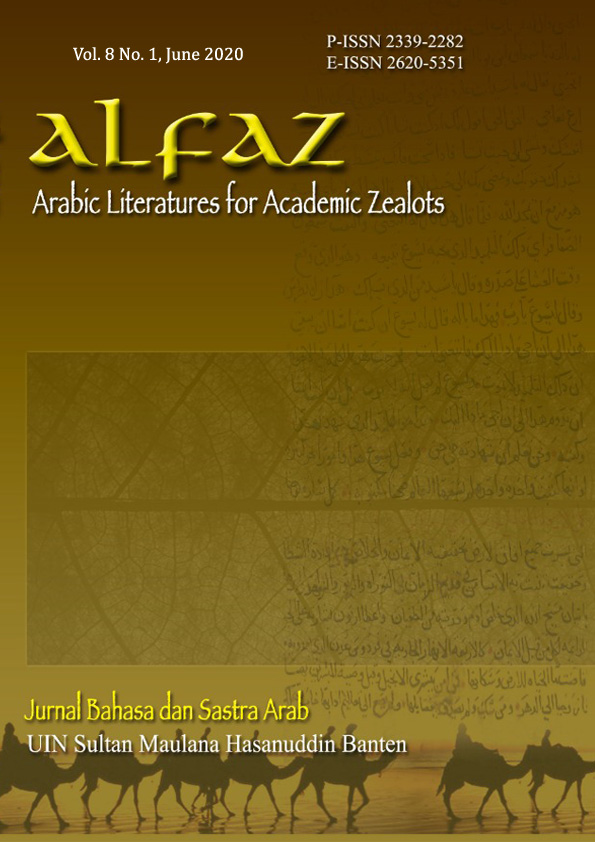Ta’rib di dalam al-Quran menurut Mazhab al-Imam Jalaludin as-Suyuty
DOI:
https://doi.org/10.32678/alfaz.Vol8.Iss1.2427Keywords:
Ta'rib, Al-Qur'an, Imam as-Suyuty, Non-Arabic wordsAbstract
This study aims at finding out non-Arabic vocabulary in the Qur'an and the perspectives of one of the most authoritative classical Qur’anic scholar, Imām as-Suyūtī on the discourse. Although the Qur'an was revealed to all mankind, the language it employs is Arabic. Even so, there are so many (perceived) non-Arabic vocabularies used in conveying the messages of the Almighty. This phenomenon has attracted the attentions of researchers to study the non-Arabic vocabularies used by the Qur’an which is called muʻarrab. The taʻrīb, the word from which muʻarrab is derived, refers to a process of formation of words in Arabic after being transferred from foreign languages. The contact the Arabs made with other people in the past can explain the emergence of muʻarrab. Amongst these people were the Persians, the Africans, the Romans, the Syrians, the Nabataeas, and others. With the contact (iḥtikāk), the Arabs found some new commodities they did not pose. They transferred new unavailable words into Arabic with some adjustments. This language phenomenon is reflected in the Qur’ān, as is confessed by as-Suyūṭī in the findings of this reseach.
Downloads
References
Abdul Aziz, Ta’rib dan Semangat Nasionalisme kebahasaan Arab, STIT al-Amin Kreo Tangerang; Jurnal Kajian Ilmu dan Budaya Islam.
Ahmadi, Rulam, Metodologi Penelitian Kualitatif, (Yogyakarta: Arruzz Media, 2006).
Asmara, Hilda Dimyati, Taʻrīib Istilah-Istilah Ilmiah dalam buku Pelajaran Biologi Kelas 3 SMA” Universitas Sultan Maulana Hasanuddin Banten; Jurnal Alfaz, Vol.7, No.2, 2019.
Azwar, Saifuddin, Metode Penelitian, (Yogyakarta: Pustaka Pelajar, 2009).
Ballasy, Muḥammad al-Sayyid ʻAlī, al-Muʻarrab fī al-Qur’ān Dirāsah Ta’ṣīliyah Dalāliyah, (Benghazi: Dār al-Kutub, 2011).
Ibnu Abī Ḥātim, Tafsīr Ibnu Abī Ḥātim, jilid 12, dalam DVD ROM AlMaktabah Al-Syamilah (Solo: Pustaka Ridwana, 2004)
Ibnu al-Jauzī, Abū al-Faraj Abdurraḥmān, Funūn al-Afnān fī Aʻyāni ʻUlūm al-Qur’ān, (Beirut: Dār al-Basyā’ir al-Islāmiyah; Cetakan pertama; 1987)
Isa, Muḥammad Haj, Al-Muaʻarab Fī Qur’ān al-Karīm, Book, 2015
Juwainī (al-), al-Imām al-Ḥaramain, Kitāb al-Irsyād, (Kairo: Maktabah al-Khānji, t.th.)
Maimun, Muhammad, Tesis “Kosa kata Asing dalam al-Qur’an” (Jogjakarta: Program Pascasarjana UIN SUnan Kalijaga, 2010).
Suyūṭī (Al-), Jalāluddīn ‘Abdurraḥmān, Al-Itqān Fī ʻUlūm al-Qur’ān, jilid II, (Beirut: Dār al-Fikr, 1979)
--------, al-Muhadzdzabu fī mā Waqaʻa fī al-Qur’ān min al-Muʻarrab, (Beirut: Dār al-Fikr, 1987).
Wahyudin, Pandangan Para Ahli Bahasa Tentang Bahasa Serapan Dalam Al-Quran. 2015, doi:10.18196/AIIJIS.2015.
Zamakhsyarī (al-), Al-Kasysyāf ʻan Ḥaqā’iq al-Tanzīl wa ‘Uyun al-Aqāwīl fī
Wujūh al-Ta’wīl, Vol. 4. (Beirut: Dār al-Fikr, 1977).
Downloads
Published
Issue
Section
License
Authors retain copyright and grant the journal right of first publication with the work simultaneously licensed under a CC BY NC SA License that allows others to share the work with an acknowledgement of the work's authorship and initial publication in this journal.







